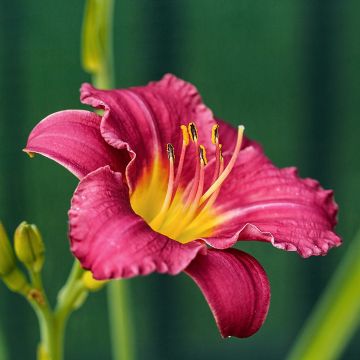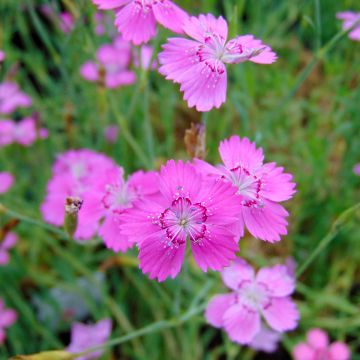

Persicaria amplexicaulis JS Delgado Macho - Mountain Fleece
Persicaria amplexicaulis JS Delgado Macho - Mountain Fleece
Persicaria amplexicaulis JS Delgado Macho
Red Bistort, Mountain Fleece
This item cannot be shipped to the selected country
Delivery charge from €5.90
More information
Schedule delivery date,
and select date in basket
This plant carries a 12 months recovery warranty
More information
We guarantee the quality of our plants for a full growing cycle, and will replace at our expense any plant that fails to recover under normal climatic and planting conditions.
From €5.90 for pickup delivery and €6.90 for home delivery
Express home delivery from €8.90.
Does this plant fit my garden?
Set up your Plantfit profile →
Description
Persicaria amplexicaulis 'JS Delgado Macho' is a unique variety of Persicaria, selected in Belgium for its more compact habit compared to other cultivars and its dazzling flowering. This dense groundcover produces short and thick flower spikes from summer to autumn. These are as bulky as the plant itself, and are a beautiful intense carmine red colour. Give it space, a slope, a ditch, or the banks around water, as well as robust companions that it won't suffocate.
Persicaria or Polygonum amplexicaule 'JS Delgado Macho' is a plant from the family of Polygonaceae. It is a recent horticultural selection, credited to the Flemish nurseryman Jan Spruyt. It originates from a species native to the Himalayas. This rhizomatous and semi-evergreen perennial forms a clump that will not exceed 50 cm in height when in bloom, 35 cm (14in) for the foliage. It spreads rather quickly, depending on soil fertility, and can form imposing clumps after several years. Particularly floriferous and colourful, this Persicaria produces numerous compact spikes, 10 cm (4in) long, at the axils of the leaves located at the ends of reddish stems. The spikes are composed of a multitude of small red flower buds that become carmine pink when they open, with a throat adorned with slightly protruding stamens. The flowering is continuous from July to October, as long as the soil does not dry out too much. The leaves, borne on sturdy stems, are wide and lanceolate, measuring 15 cm (6in) long. They are vivid green, villous on the underside, and turn violet in autumn.
Like masterworts, Persicaria are very popular plants, thanks to their good adaptation to cold and wet climates and their clean appearance that suits contemporary gardens as well as naturalistic and romantic flowerbeds. They form magnificent autumn scene with grasses like Miscanthus and Panicum. Thanks to its low and spreading habit, Polygonum 'JS Delgado Macho' can be used as a groundcover, as long as it is given enough space. Persicaria enjoys full sun but also partial shade. It prefers rich and heavy, even very wet soils and can be grown independently on sunny pond banks, along a sunken path, or in a cool and partially shaded woodland at the base of trees. Asters, Japanese anemones, and Inula are good companions for Persicaria, both in the garden and in bouquets, as they also flower until autumn. Dead nettles and bergenia, equally robust, allow for extending the flowering periods and provide contrasting forms and foliage.
Report an error about the product description
Persicaria amplexicaulis JS Delgado Macho - Mountain Fleece in pictures




Flowering
Foliage
Plant habit
Botanical data
Persicaria
amplexicaulis
JS Delgado Macho
Polygonaceae
Red Bistort, Mountain Fleece
Cultivar or hybrid
Other Persicaria
Planting and care
Persicaria amplexicaulis 'JS Delgado Macho' thrives in sunny or semi-shaded exposure. It is a very easy plant to grow, it even tolerates moderate drought if the soil it receives is deep. Plant it in spring or autumn, in any type of soil, as long as it is fresh, clay or humus-rich, even marshy, in groups to create a mass effect. Enrich the soil with organic fertiliser at the start of the growing period, as it is a greedy plant. Control its growth so that it does not harm neighbouring plants. Mulch the soil in June in regions where the summer is hot and dry. Divide the clumps in October every three years and replant the plants in another part of the garden.
Planting period
Intended location
Care
This item has not been reviewed yet - be the first to leave a review about it.
Summer flowering perennials
Haven't found what you were looking for?
Hardiness is the lowest winter temperature a plant can endure without suffering serious damage or even dying. However, hardiness is affected by location (a sheltered area, such as a patio), protection (winter cover) and soil type (hardiness is improved by well-drained soil).

Photo Sharing Terms & Conditions
In order to encourage gardeners to interact and share their experiences, Promesse de fleurs offers various media enabling content to be uploaded onto its Site - in particular via the ‘Photo sharing’ module.
The User agrees to refrain from:
- Posting any content that is illegal, prejudicial, insulting, racist, inciteful to hatred, revisionist, contrary to public decency, that infringes on privacy or on the privacy rights of third parties, in particular the publicity rights of persons and goods, intellectual property rights, or the right to privacy.
- Submitting content on behalf of a third party;
- Impersonate the identity of a third party and/or publish any personal information about a third party;
In general, the User undertakes to refrain from any unethical behaviour.
All Content (in particular text, comments, files, images, photos, videos, creative works, etc.), which may be subject to property or intellectual property rights, image or other private rights, shall remain the property of the User, subject to the limited rights granted by the terms of the licence granted by Promesse de fleurs as stated below. Users are at liberty to publish or not to publish such Content on the Site, notably via the ‘Photo Sharing’ facility, and accept that this Content shall be made public and freely accessible, notably on the Internet.
Users further acknowledge, undertake to have ,and guarantee that they hold all necessary rights and permissions to publish such material on the Site, in particular with regard to the legislation in force pertaining to any privacy, property, intellectual property, image, or contractual rights, or rights of any other nature. By publishing such Content on the Site, Users acknowledge accepting full liability as publishers of the Content within the meaning of the law, and grant Promesse de fleurs, free of charge, an inclusive, worldwide licence for the said Content for the entire duration of its publication, including all reproduction, representation, up/downloading, displaying, performing, transmission, and storage rights.
Users also grant permission for their name to be linked to the Content and accept that this link may not always be made available.
By engaging in posting material, Users consent to their Content becoming automatically accessible on the Internet, in particular on other sites and/or blogs and/or web pages of the Promesse de fleurs site, including in particular social pages and the Promesse de fleurs catalogue.
Users may secure the removal of entrusted content free of charge by issuing a simple request via our contact form.
The flowering period indicated on our website applies to countries and regions located in USDA zone 8 (France, the United Kingdom, Ireland, the Netherlands, etc.)
It will vary according to where you live:
- In zones 9 to 10 (Italy, Spain, Greece, etc.), flowering will occur about 2 to 4 weeks earlier.
- In zones 6 to 7 (Germany, Poland, Slovenia, and lower mountainous regions), flowering will be delayed by 2 to 3 weeks.
- In zone 5 (Central Europe, Scandinavia), blooming will be delayed by 3 to 5 weeks.
In temperate climates, pruning of spring-flowering shrubs (forsythia, spireas, etc.) should be done just after flowering.
Pruning of summer-flowering shrubs (Indian Lilac, Perovskia, etc.) can be done in winter or spring.
In cold regions as well as with frost-sensitive plants, avoid pruning too early when severe frosts may still occur.
The planting period indicated on our website applies to countries and regions located in USDA zone 8 (France, United Kingdom, Ireland, Netherlands).
It will vary according to where you live:
- In Mediterranean zones (Marseille, Madrid, Milan, etc.), autumn and winter are the best planting periods.
- In continental zones (Strasbourg, Munich, Vienna, etc.), delay planting by 2 to 3 weeks in spring and bring it forward by 2 to 4 weeks in autumn.
- In mountainous regions (the Alps, Pyrenees, Carpathians, etc.), it is best to plant in late spring (May-June) or late summer (August-September).
The harvesting period indicated on our website applies to countries and regions in USDA zone 8 (France, England, Ireland, the Netherlands).
In colder areas (Scandinavia, Poland, Austria...) fruit and vegetable harvests are likely to be delayed by 3-4 weeks.
In warmer areas (Italy, Spain, Greece, etc.), harvesting will probably take place earlier, depending on weather conditions.
The sowing periods indicated on our website apply to countries and regions within USDA Zone 8 (France, UK, Ireland, Netherlands).
In colder areas (Scandinavia, Poland, Austria...), delay any outdoor sowing by 3-4 weeks, or sow under glass.
In warmer climes (Italy, Spain, Greece, etc.), bring outdoor sowing forward by a few weeks.
























































